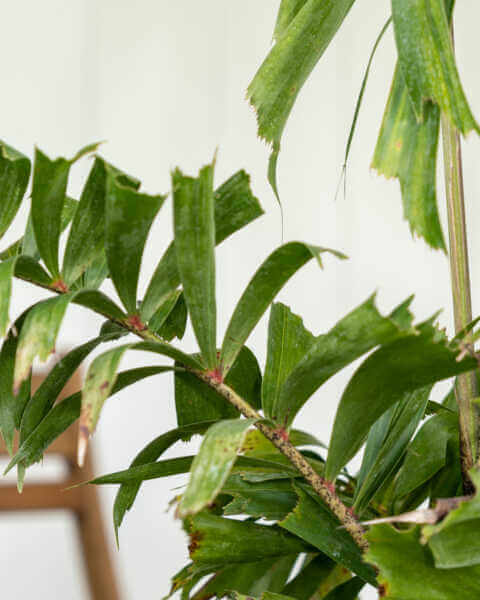This post may contain affiliate links. As an Amazon Associate we earn from qualifying purchases.
The foxtail palm tree (Wodyetia bifurcata) takes its name from its spectacular foliage — each fluffy frond resembles a fox’s tail.
It has a single, grey trunk that grows to 30 feet in height with a 20-foot wide canopy. The Foxtail palm tree tolerates a wide range of soil types and textures and thrives in full sun.
Foxtail palms do well in containers and make an ideal accent planting around a pool, on patios or indoors. Foxtail palms have deep root systems that require extra care when transplanting.

What is Shock?
Most palms experience a period of transplant shock when moved from one location to another, and for several reasons:
- Roots may dry and harden when exposed to too much direct sun or air.
- The act of digging up the tree damages the roots, and the tree generally loses a great deal of the root system.
- Because the tree itself didn’t diminish in size and still uses the same amount of water, the smaller root system may be unable to deliver the amount of water the tree needs.
Potted foxtail palm trees experience shock as well, although not as severe as those grown in the ground.
Symptoms of Foxtail Palm Tree Shock
A common symptom of shock is foliage dying. To conserve its nutrients and deal with the loss of part of its root system, the tree also sheds leaves.
Foliage may remain on the tree but turn mottled or discolored. Subtle signs of shock include slow top growth during the year following the transplant procedure. These are all symptoms of the tree attempting to acclimate to its new environment.

Solution
First, don’t freak out. Remember that transplant shock is common. Because root growth is fastest when air and soil temperatures are warm, don’t transplant the foxtail palm tree in the winter — summer is ideal.
The best treatment, however, is to keep the tree’s roots moist while it becomes established in its new location. Water the foxtail palm slowly and deeply, but don’t allow the soil to remain soggy.

How to Properly Transplant the Foxtail Palm Tree
The best way to prevent severe transplant shock is to fully prepare the foxtail palm tree before transplanting. Keep the rootball saturated for the week leading up to the procedure.
Then, transplant the foxtail palm in the evening when there is less direct sun.
Remove the palm from the pot carefully, trying to keep as much soil around the roots as possible. Reserve any soil that falls off and use it to pack around the roots when the plant is placed into the new hole or pot.
Sprinkle water over the roots until they are damp and then dust them with mycohorrizal fungi (promotes root growth). You can purchase this at Amazon.com.
Ensure that the new hole is twice as wide at the root ball but only as deep as the tree has been growing. Place the foxtail palm tree in the hole and fill the pot with soil until it’s half full. Run water into the hole until it’s full and allow it to drain. This will help remove air pockets in the soil. Then, finish filling the hole (or pot) with soil.
If the foxtail palm tree won’t be on a drip irrigation system, mound soil into a 6-inch high dam, placed at the outer edges of the hole, completely surrounding the tree. Fill it with water and allow it to drain.
Next, add a 3-inch layer of mulch to the soil, keeping it at least 6 inches from the foxtail palm tree’s trunk.
Keep the soil moist as the foxtail palm tree becomes established and, again, don’t go into shock if the tree does. It’s quite normal and it should survive.



